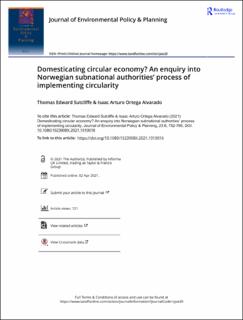| dc.contributor.author | Sutcliffe, Thomas Edward | |
| dc.contributor.author | Ortega Alvarado, Isaac Arturo | |
| dc.date.accessioned | 2022-02-28T15:50:13Z | |
| dc.date.available | 2022-02-28T15:50:13Z | |
| dc.date.created | 2021-04-02T23:37:33Z | |
| dc.date.issued | 2021 | |
| dc.identifier.issn | 1523-908X | |
| dc.identifier.uri | https://hdl.handle.net/11250/2981874 | |
| dc.description.abstract | This article focuses on the introduction of the concept of circular economy into a Norwegian context by concentrating on two levels of subnational authorities against the backdrop of the national level. By drawing on recorded qualitative data collected in the region of Trøndelag and Oslo, we deploy the concept of domestication to analyse how the diffusion of CE as a political, future-oriented concept is appropriated, i.e. through symbolic, practical and cognitive dimensions. Additionally, we consider the performativity of the future as a component in the adoption of the concept. Our findings suggest that the adoption of CE at these levels of governments in Norway is an ongoing process where the co-construction of the dimensions happens concurrently. Relating to the future, the national level takes a translative approach and goes after an increased interest and activity by private actors. At the first subnational level, in the case of the Trøndelag county, the public sector operates as a channel between knowledge of best practices and private actors who can mobilise action. Meanwhile, at the third subnational level, we find at the municipality of Trondheim, a public authority that proactively changes specific practices and regulates (or normalizes) the CE through their own means. | en_US |
| dc.language.iso | eng | en_US |
| dc.publisher | Taylor & Francis | en_US |
| dc.rights | Navngivelse 4.0 Internasjonal | * |
| dc.rights.uri | http://creativecommons.org/licenses/by/4.0/deed.no | * |
| dc.title | Domesticating circular economy? An enquiry into Norwegian subnational authorities’ process of implementing circularity | en_US |
| dc.type | Peer reviewed | en_US |
| dc.type | Journal article | en_US |
| dc.description.version | publishedVersion | en_US |
| dc.source.journal | Journal of Environmental Policy and Planning | en_US |
| dc.identifier.doi | 10.1080/1523908X.2021.1910016 | |
| dc.identifier.cristin | 1901993 | |
| cristin.ispublished | true | |
| cristin.fulltext | original | |
| cristin.qualitycode | 1 | |

